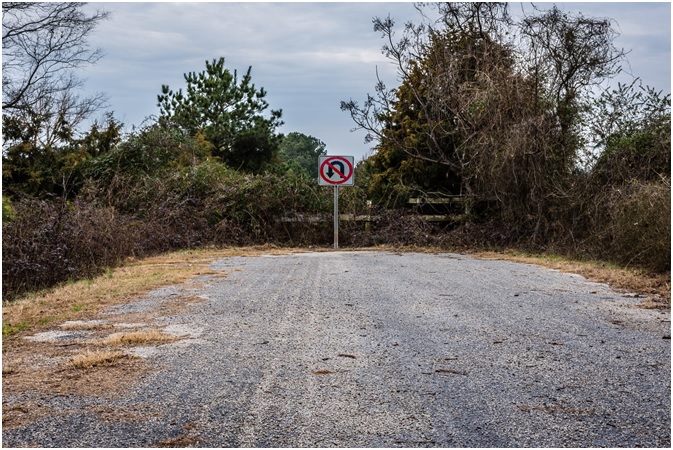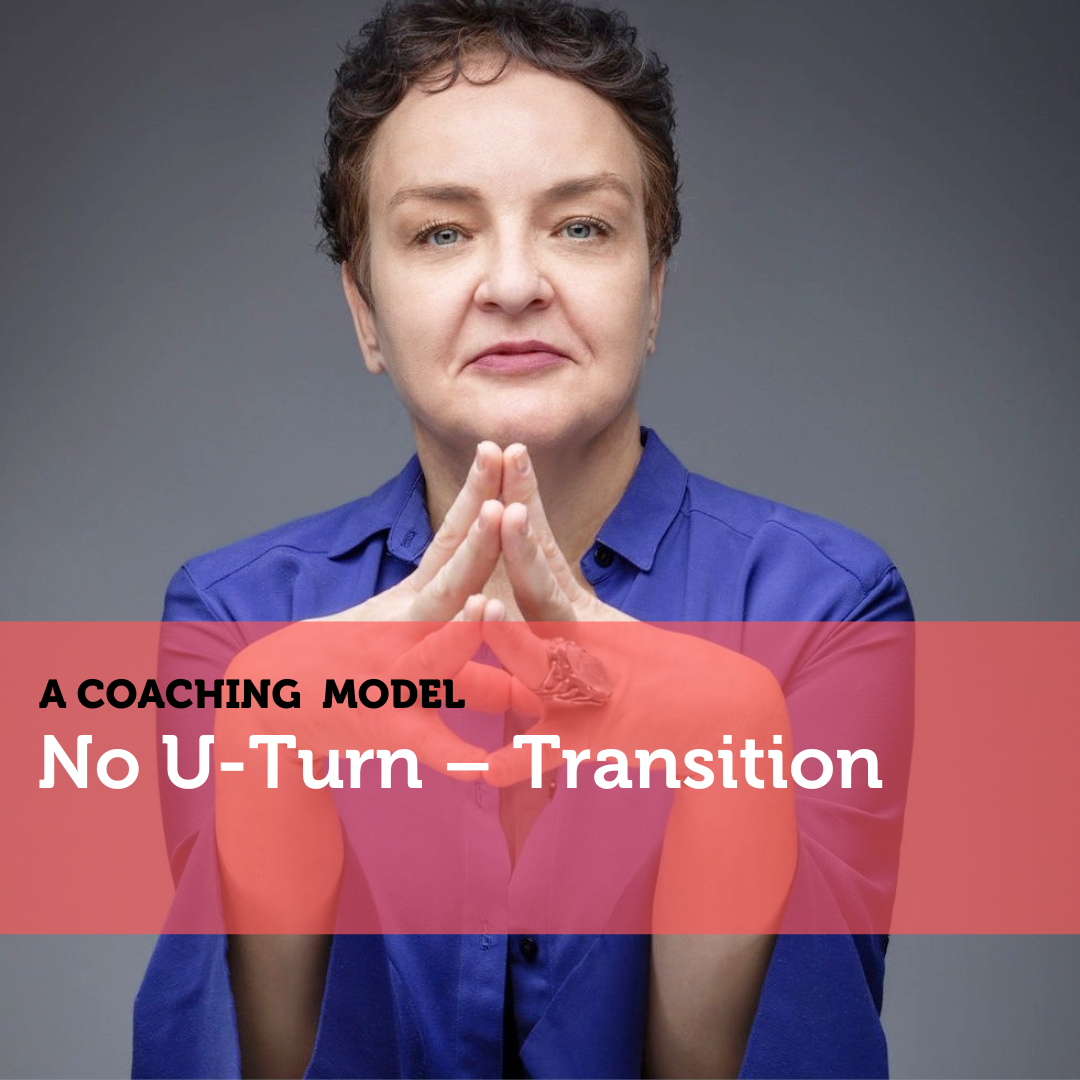A Coaching Model By Monika Sałach, Burnout Coach, UNITED ARAB EMIRATES
Understanding No U-Turn – Transition

Transition
Imagine you find yourself in a place like this:
Maybe you were happily driving and suddenly stopped here, not knowing what to do. Or someone brought you here and left you with just a few pieces of luggage. You might have intuitively known that the road would change, but you didn’t expect this to happen so quickly. Or you planned for getting to a new place, but now it looks like it may be more difficult than you thought. Anyway, the question is – what now? Regardless of how much time you spend questioning why it happened to you, what the options are, and what is awaiting you over the fence and in the bushes, at some point you have to pack only the necessary things into your backpack, take one last look at what you are leaving behind, and start walking. You are doing this because you can neither go back nor stay here, but you also hope to soon find a new road, better than the old one, which will lead you to new places. You can sense that both adventure and fear of this unknown path will change you forever.
It is a cliché to say that our life is a journey, but it really is. There are times when we can find ourselves in such places – life as we knew it is coming to an end or we are no longer comfortable with it. We want to or should proceed, but we are not sure about our direction or our goals. This can happen when we are “emerging adults”, starting a new independent life, when we start a family or go through a divorce, retire, go through quarter-life, mid-life, or any other existential crisis. A simple change of job, partner, or place to live is not enough, so we need to re-invent ourselves in a process of Transition.
The transition was defined by author, consultant, and international speaker William Bridges in 1979:
(…) change is situational. Transition, on the other hand, is psychological. It is not those events, but rather the inner reorientation and self-redefinition that you have to go through in order to incorporate any of those changes into your life. Without a transition, a change is just a rearrangement of the furniture. Unless transition happens, the change won’t work, because it doesn’t‘take’. William Bridges, Transitions: Making Sense of Life’s Changes
Bridges proposed a simple but powerful Transition Model applicable both to individuals and organizations going through a transition. The model contains just 3 steps:
- The Ending
- The Neutral Zone
- The New Beginning
Let’s see how the idea of Transition, Bridges’ Transition Model, and standing in front of the “NoU-Turn” sign at the end of the road merge in my proposed coaching model.
No U-Turn Coaching Model
Regardless of whether you are physically standing at the end of the road and see only a fence and a forest in front of you, or you are facing a deep life change requiring you to redefine yourself and take action, the steps you will have to take are similar. For the life transition, you can walk through it with a coach, who can support you in a deeper understanding of yourself during the journey, in making decisions, keeping you motivated in difficult times, and finally achieving the goals and the inner change that you wanted.
1. Say Goodbye to the Old Path
When your car stops in front of the “No U-Turn” sign, take your time to reflect on what brought you here, what you are leaving behind, and who you are at this moment. You will start realizing that you cannot go back and you need to find a new place for yourself. Take your time, you really have to accept that there is no return.
In a coaching situation, you will talk about your past and present, and start preparing for a farewell:
- What situation are you in? What makes it a “No U-Turn”?
- Who are you? What are your values, priorities, and beliefs?
- What are you proud of? What do you love about yourself and what you would prefer to change?
- What is difficult to leave behind? How can you take part of it or its memory with you?
- What unfinished business do you have, if any?
- Are you ready for the next step?
2. Prepare for Your Journey
Once you know who you are and why you are here, and you decide that it is time to move on, you need to spend some time preparing for this exciting but sometimes scary journey. You have to decide what to put in the small backpack you will carry with you and what to leave completely. You may want to look back and take a last photograph of your past before switching your mind to looking forward.
The coach would ask you questions like:
- What is the goal of your transition?
- Who do you want to be?
- Which values and priorities are you unwilling to compromise?
- What options do you see?
- Fear is normal, but what can you do to contain it?
- How can you keep yourself motivated to continue the transition until the end?
- How will you know that you have reached the goal?
- How can you switch from doubt, insecurity, fear, and longing for the past to the belief that you will end up in a new, exciting place?
- What challenges do you expect to meet? Who can support you?
- Are you ready for the next step?
3. Walk, Walk, and Walk a Little More…
It is time to jump through the fence and start walking. You are looking into the bushes behind the fence and have to decide which way to go. You may see one small trail among the trees or several trails to choose from. There may also not be any trails and you will just start going step by step among the trees and bushes; anyway, the transition journey starts with the first step. You will frequently check if you are still on track to reach your goals, because the path may not be straight, and you may have to go back a little and change direction. Or you may even decide to change your goals if you learn something new about yourself along the way.
The coach will walk beside you during the entire journey, helping by discussing with you:
- How do you feel about your journey so far?
- Where are you in relation to your goals?
- What have you learned about yourself so far?
- What are the changes in your values and priorities?
- What changes in the goals or directions do you want to make, if any?
- How can you keep yourself motivated and accountable?
- What are and maybe the barriers on your way? Who can help you?
4. Welcome to the New Path
Finally, you leave the forest and you see a new road inviting you to continue the journey with new adventures, experiences, and challenges. But before you proceed, you stop for a while and reflect on the transition that just happened.
You talk with the coach to check:
- Who are you now?
- How did your values, priorities, and beliefs change?
- What are you looking forward to?
- What are your plans?
- What have you learned about yourself in the transition?
- How can you apply this learning to other aspects of your life?
- Are you ready to part with the coach? 😊
Learn How to Create Your Own Coaching Model
Your Coaching Model reflects your values,
philosophies, and beliefs and must communicate who you will coach
and the problems you will solve. Read more about creating your coaching model
References
W. Bridges, Transitions. Making Sense of Life’s Changes, New York: Hachette Books, 2019.
Original Photos Credentials (Modified for the Purpose of the Model):
Photo 240210252 © Stephen Waycott | Dreamstime.com
Photo 87549189 / No Turn © Tim Gray | Dreamstime.com
